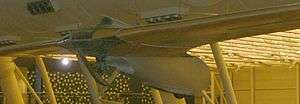Horten H.VI
| H.VI | |
|---|---|
 | |
| Role | High performance sailplane |
| National origin | Germany |
| Manufacturer | Horten |
| Designer | Walter and Reimar Horten |
| Number built | 2 |
| Developed from | Horten H.IV |
The Horten H.VI was a flying wing aircraft designed by the Horten brothers during World War II.
Based on the Horten H.IV, the H.VI was an enlarged version of the H.IV, with the goal of comparing their flying wing designs against the very large span Akaflieg Darmstadt D-30 Cirrus.
The Horten H.VI was also given the RLM designation Horten Ho 253.[1]
Specifications (H.VI V2)
Data from Sailplanes 1920-1945[2]
General characteristics
- Crew: 1
- Length: 2.5 m (8 ft 2 in) centre-section (wing-tips extended past the end of the centre-section)
- Wingspan: 24.25 m (79 ft 7 in)
- Height: 1 m (3 ft 3 in)
- Wing area: 17.8 m2 (192 sq ft)
- Aspect ratio: 32.4
- Empty weight: 330 kg (728 lb)
- Gross weight: 410 kg (904 lb)
Performance
- Never exceed speed: 200 km/h (124 mph; 108 kn)
- Maximum glide ratio: 1:43
- Wing loading: 23 kg/m2 (4.7 lb/sq ft)
References
| Wikimedia Commons has media related to Horten H.VI. |
- ↑ http://www.designation-systems.net/non-us/germany.html
- ↑ Simons, Martin (2006). Sailplanes 1920-1945 (2nd revised ed.). Königswinter: EQIP Werbung und Verlag G.m.b.H. ISBN 978-3-9806773-4-9.
This article is issued from Wikipedia - version of the 11/26/2016. The text is available under the Creative Commons Attribution/Share Alike but additional terms may apply for the media files.